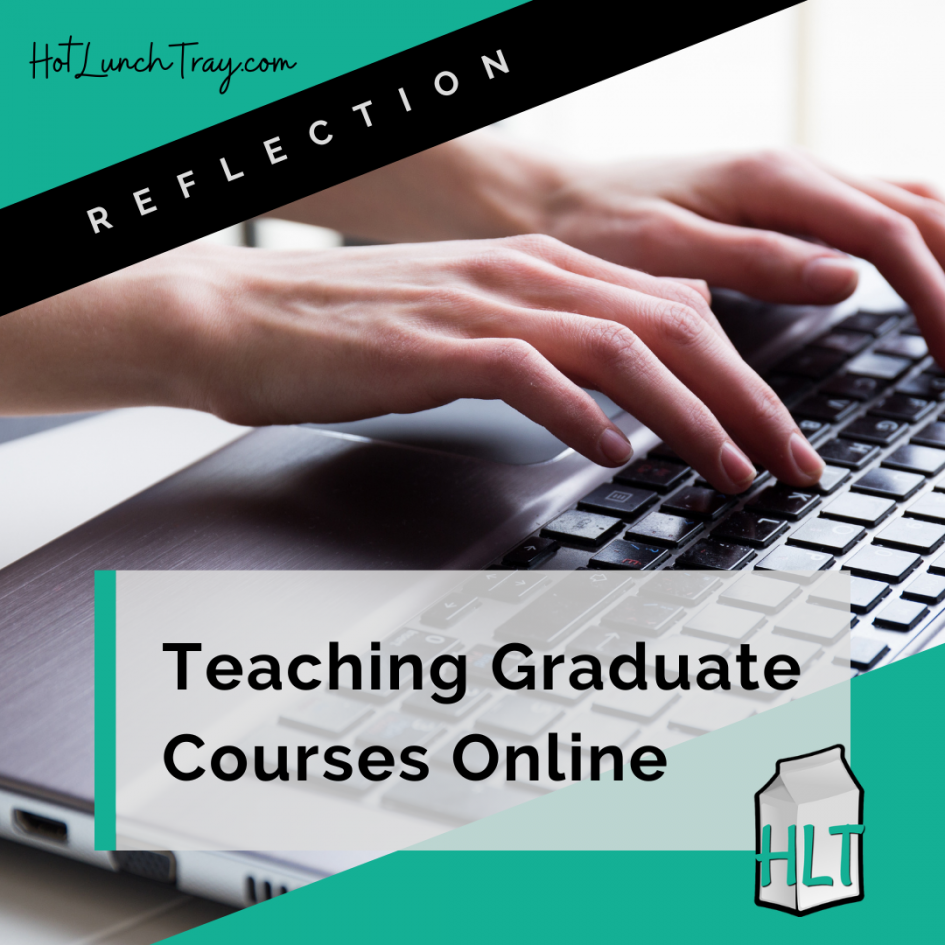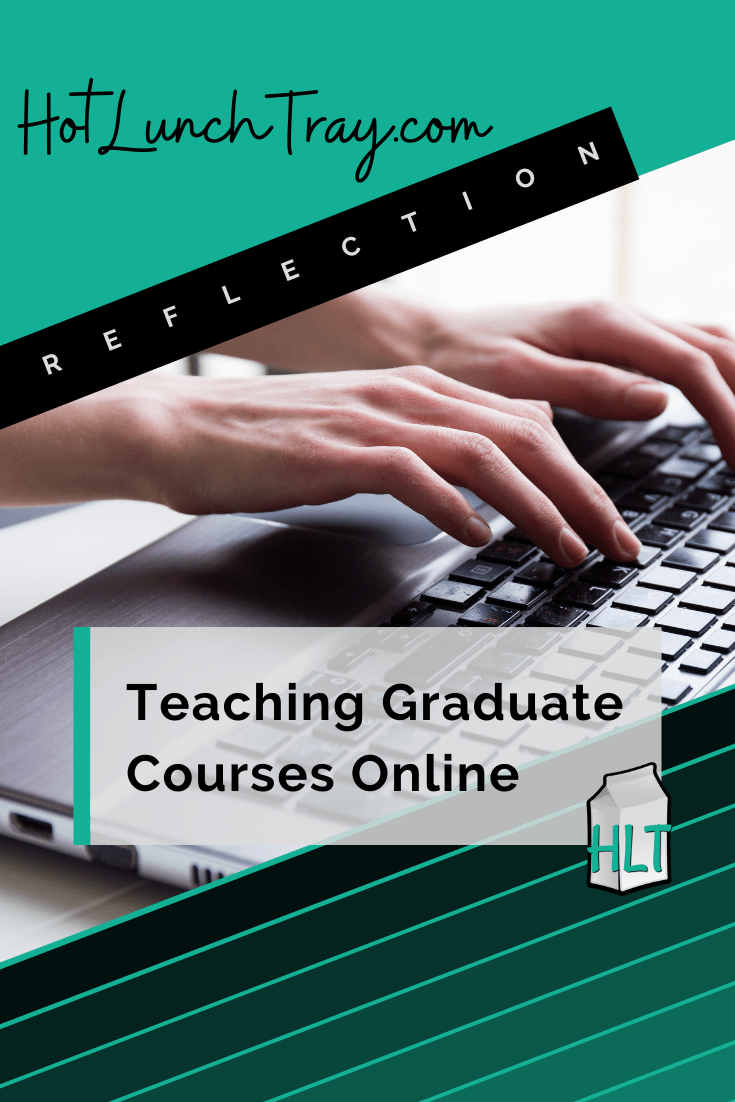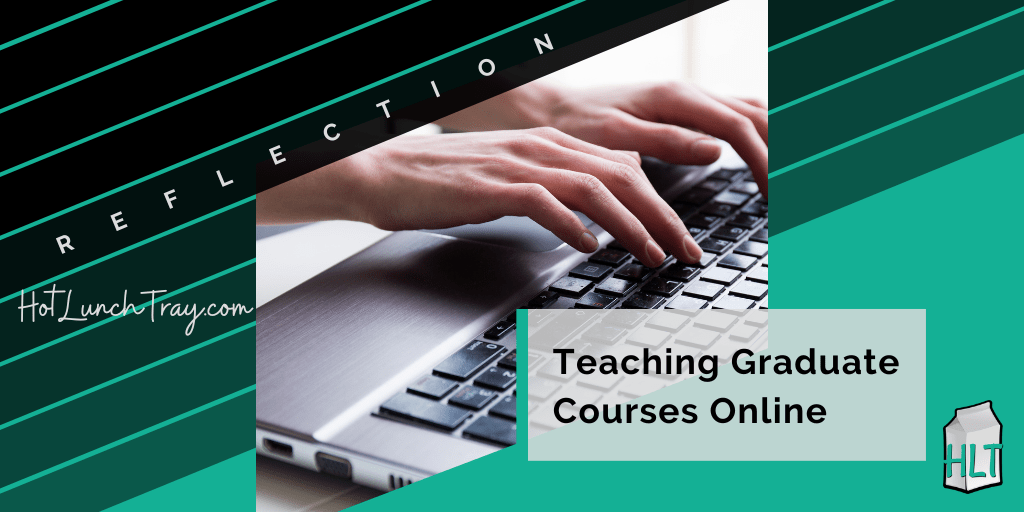I chose my last degree program based on three criteria. First, I wanted to find an online school that utilized the learning management system with which I was most comfortable. Second, I needed an affordable option with an easy payment plan. And lastly, I wanted a program with good student reviews. 🎊 I am happy to report that 21 months after graduating I have paid off my doctorate in instructional technology. 🎊
Teaching Graduate Courses Online
Allow me to share my reflection on teaching graduate courses online. When I wanted to teach graduate courses online I started with that same institution for many of the same reasons. The participants in these courses would be most like me. Likely they are already working in their field of study, will have extensive experiences to share, and are less philosophical than practical. My people. After two rounds of application, I was hired as an adjunct instructor and am coming up on my first anniversary.
Table of Contents
Logistics
My initial challenges were logistical. I had a working schedule as a learner in this institution’s course structure, however, I had to consider what I needed to front-load as the instructor. The most challenging aspect was reading all the module readings in advance of each module. I knew that once I had taught each course I would have a better handle on the readings and have to only read the new resources as they were added. Reading the syllabus was instrumental for me to discern what the nuances were between the courses in a program and assignments compared to each other. While I say the least about this, predictably this took me the longest to feel confident in!
Customize the Course
Once I had an idea of the workload for the instructor role, I was now ready to customize the course experience as an instructor. This is where I set both my intentions for interactions and non-negotiables for my learners. I needed to create a Communication Plan for (1) my teaching style which (2) fit the requirements of the course and the (3) capabilities of the learning management system (LMS). Read this if you need to consider tools outside of your LMS: Interaction is Virtual Communities.
My communication plan includes building teacher presence through weekly (+) announcements, a general or Q&A discussion board, and individual student messages. I am also testing a live course kick-off session which I share with the discussion board and the next announcement. I expect my communication plan to evolve with my experience, student feedback, and institutional changes.
One of my secondary goals is to create a Community of Inquiry (COI). Not all courses or cohorts interact at this level. But I try to encourage the social aspects of the course, interact in an academically rigorous manner to promote the cognitive goals of the course, and intentionally curate my teaching presence. When well-developed, COI can create a deep and meaningful (collaborative-constructivist) learning experience. Honestly, this is a rarity in my courses so far. I intend to keep trying to grow this but have not yet identified the best ways for me to accomplish this.
Another secondary goal is to promote Social Presence among learners. This is self-interested because my assumption is the course content will be their topic of conversation. Social presence is something that happens naturally in the in-person classroom but takes effort when teaching graduate courses online. I encourage participants to post for each other in our Q&A discussion; I ask them to share any formatting techniques, share discoveries that others might benefit from, or ask others how they accomplished things in our assignments. Students typically also develop a back channel for less formal discussions too, which I encourage!
Any online course requires a communication plan. As the online teacher, the goal is to broadcast the same message on multiple channels, allowing participants to receive communication via their preferred channel. The message discipline required to maintain the same message across platforms and within tight time frames is what can make communication effective (or not). If messages vary some participants will receive better/worse information than others. If the timing between platforms lags, some students will receive information before/after other students. When either of those happens the students tend to blame the teacher; avoid that by scheduling adequate time to schedule/create all messages and copy/paste them into each platform to send as immediately and close together as possible.
Announcements
Asynchronous teacher presence is essential to plan before the course begins. You may have to try some different cadences and formats in your announcements to find the right fit for you. Often these can be scheduled in your LMS and creating a batch of announcements can help you be consistent in the format, increasing readability and value to your students. Even when scheduled, you can still edit before an announcement is sent to add some timely feedback or announcement.
Get started
Introduce yourself to your online classroom, I recommend a video introduction as possible. A synchronous video offers the participants the chance to interact with you. An asynchronous video offers you the chance to be certain to cover all your content. A recording always offers your participants the ability to rewind and replay if needed and is an easy value-add for you to provide.
When introducing yourself smile with your entire face and your voice. Allow your learners to know you have a family and a career, and value those facets of them as well. When introducing your course consider highlighting what participants receive by successfully completing this course (many adjuncts are paid or evaluated by headcount). In order to maintain interest and satisfaction in the quality of the online experience identify the features and benefits of the course/format/interactions. This often invites interaction from the participants in the form of questions – that means they watched it!
Keep it going
Set an announcement schedule and stick to it. The predictability of your announcements may determine their success. Consider that online graduate students need to settle into their own pattern to complete work. The two best times of the week to send an announcement is Monday or Friday. If an announcement goes out Monday it is a preview of the week to come, maybe a mention of what happened last week to build to this week’s content and learning, and any noteworthy items to pay special attention to during the week. If an announcement goes out Friday it is a review of the past week with a view toward how the week’s learning will connect to next week’s learning. Upcoming dues dates and items of importance should be mentioned as well.
Discussion Boards
Depending on the format of your online classroom, a discussion board can be an easy way to make course adjustments and address any misconceptions. A discussion board also promotes equal access to shifting information or understanding. Students who may not ask the instructor questions, or even consider that option, can benefit from any changes or refinements during the course. You may have to model discussion board best practices. For instructors, I suggest you start each response to a student question with:
“{Name} thank you for that question..”
Individual Communications
Instructors have the flexibility to balance their individual communication methods as a way to personalize their course. Consider that some participants may prefer options other than voice or web conferencing interactions. Basic individual communications all students can expect include LMS feedback on graded submissions, LMS messaging, and/or email for communication {read: email hacks}.
Instructors can take advantage of efficiencies in these categories. Utilize the LMS as your students are likely already trained in that platform, however, be open to other ways to make your job easier. Consider email calendars for meetings, auto-schedulers (#AFF Recommendation: Calendly) to arrange future meetings, efficiencies in grading, and feedback {read: grading online submissions}.
Remember your message discipline when communicating with individuals. If your individual message varies from other places in the course you may be training students to message you individually – and repeatedly. And that is very inefficient for you and confusing for your participants.
Messages
Your course messages may include traditional emails, LMS messages, or both. Either way, messages should not be knee-jerk responses, the quality of the responses is more important than the immediacy of the response. Know the institutions messaging expectations. Consider if you are training students to message you as a chat feature by your cadence of response (Read: Email Hacks: Teacher Efficiency).
All messages you send are meant to be proofread until clear to any recipient. Prepare yourself to accept length over lack of information. Use text features in emails; headings, bold features, and lists as they can clarify and guide the recipient to clarity.
Feedback
It is typically more efficient for teachers to check submitted assignments all at once. Do not check assignments one at a time as they come in, but instead, monitor the channels participants have for questions on assignments, evaluate the first submissions to assure directions were clear enough, and then wait until after the due date to grade. While there may still be those who have to turn the assignment in, you can remind them of the due date while you start grading. Ideally, the assignment has a rubric for precise grading and the teacher of record provides additional feedback.
To model quality feedback I copied the part of the rubric which listed things to do, consider, and include in a discussion or assignment. I paste those into a notepad document I keep with all my specific, neutral, forward-looking feedback per assignment, per course. Consider this workflow for providing specific feedback without writing each submission from scratch.
You might see (in the above workflow) that I use emojis; emojis act as bullet points and convey a tone that could be lost with only written communication. I like emojipedia but unicode and the noun project are also places I use. Use them in any form of communication to convey your tone and confident optimism about the goals of the course.
Video
The ultimate is a customized message could be a video message. Many LMS allow this in announcements, discussion boards, and messages within their platform. You have control over your tone expressed in video feedback. This format may also be the most efficient. Consider a lengthy submission, a big idea, or a personalized message and ask yourself if you would rather speak the message than type it; this method was my go-to when teaching a high enrollment research course.
Personalize the Course
Finally, I was ready to individualize the learner experience. For me, that was a guiding principle that I support each student in the way they asked to be supported without taking over their learning experience. Learners were paying for this course within a program that should increase their skills, understanding, and productivity in their careers.
Immediate Application
In that light, if a learner asked me to be flexible in constraints that did not contradict the spirit of the assignments or the grading rubric I committed to myself that I would be flexible. While I left this to students to request, I found that professionals would ask if they could adjust some aspects of coursework to double the coursework for usable content in their careers. As long as this still conformed to the spirit of the assignment and did not deviate from the grading rubric I would typically agree to their proposals; occasionally, I had to counter with some additions to their proposal and advised them to simply remove those additions to use the product for themselves. Most often the requests center around length or time constraints, occasionally submission formats, and sometimes the option to work ahead or repurpose existing self-published content.
Program Progress
Students can join the programs in which I teach in any term. With the exception of a few courses, every term I assumed any question could be from someone in their first or last course in the program. That might mean I had to explain the course or assignment layout. If that were the case, I would typically meet with that student one-on-one either by phone or video conference. Immediately after that meeting, I recapture the question or clarification in a video and post it to the course-wide Q&A discussion board. As needed it would also make the next week’s announcement. The one person that had that questions often represents multiple participants that have not yet asked or did not want to ask.
I have had students that needed to revisit the college orientation resources. Any new adjunct should learn what resources are available at their college. I had access to success coaches who work directly with students. Between the college orientation resources, a student’s coach, and my department leader I have been able to direct students to the assistance they need.
My Non-Negotiables
Of course, I did have a few students who were not yet independent learners or out of practice. I would return to my intentions for interactions and non-negotiables for my learners. I gladly host one personalized session and then move to one-on-one communication through the LMS messaging or email per learner preference. This move to written communication is helpful to document how I helped them and what I expected them to do next. I used phrases like:
- “For future success in this class and in your program…”
- “Moving forward please make certain that you...”
- I referenced the rubric to show them how to “select the grade you would like…“
- For students who wanted exemplars, I shared that “...the freedom of this assignment is that you can customize for your use after this program..as long as you meet the assignment and rubric requirements…” When grading these assignments for these specific students, I praise their creativity and how the product was not something I anticipated but it “…aligned with the assignment and/or rubric…” If I note that as a trend, I mention it in either the course Q & A discussion or the next week’s announcement.
Benefits
I like helping other practitioners in a personal area of interest and strength. But of course, there are benefits for me. It is a way to make some extra income that I can do from anywhere at any time. There are some specific benefits though that will likely keep me teaching graduate courses online in the near future.
Database access
Lifelong learners can benefit from access to the college library. You do not have to find ways around a paywall to read the most recent research in your area of expertise. I consider this almost a monetary benefit as I have paid for individual article access.
Continuing education
Some colleges offer a tuition benefit for adjuncts. Research if it is for select programs, extends to dependents, there is a time requirement, is it a percentage of the cost, or has an annual cap. If you are an educator this is an excellent way to earn your next degree.
Staying grounded
I receive very real feedback from active professionals teaching graduate courses online. Since the course participants are consumers of a product, this is different feedback than with educators in the classroom. When working with educators in the classroom, I am in a change management, training, or professional development capacity. In the latter, the learning is compelled by the school or district and often after the fact (as in the strategic decision has already been made or the program/application is already purchased). In the former, these are customers of a college who are reacting to the value of what they are purchasing.
Participants provide candid feedback on programs and training they participate in via peers and assignments within the course. This is valuable insight that educators in my district may not feel empowered to share. This covert research informs how I approach my future training and adjust integration to classrooms for applications and programs I promote and my training.
What about you?
Are you interested in teaching graduate courses online? Let me know if you are interested in talking about my referral to teach at my college. I would be interested in your current degree status and teaching experience. But mostly I’d love to answer any questions you have before applying.








Leave a Reply